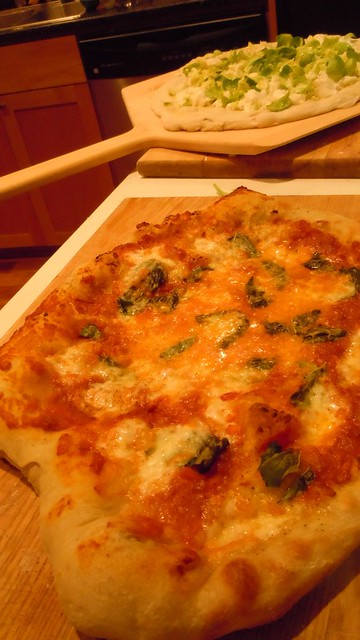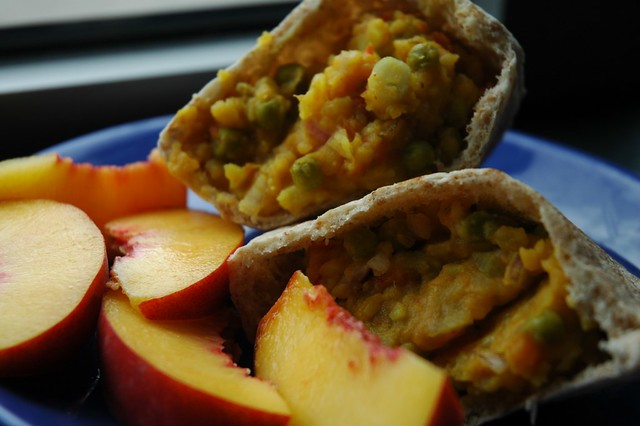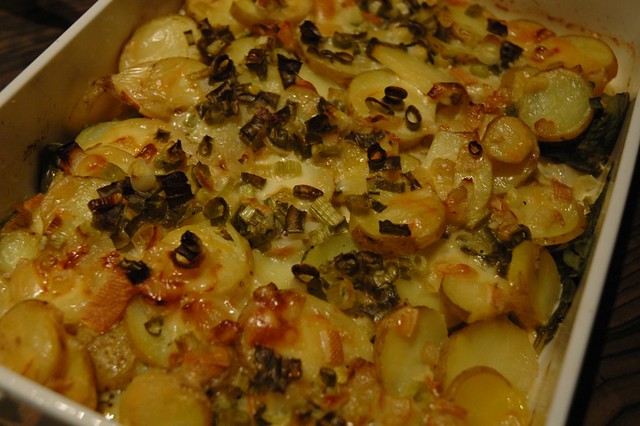February 29, 2012
March MoMe
Here is the Month of Meals for March. I'm sorry the links for the png below won't load! =/ They are active on the pdf version.
I’ve gotten a lot of positive feedback from my friends that have used this and they often remark that I’m organized to plan things for an entire month. I would like confess that although I use this as a framework for meals, I often venture out and try new things, and switch up meals regularly. The grocery lists help me to buy things and make healthy meals. So, Holly, use this as a tool for long-term planning, and feel free to deviate from it.
Personally, while I have used this it’s helped me see how much cheese I eat! While I certainly love cheese, I do think about it as a food to enjoy sparingly because of it’s high saturated fat content. With many cheeses I think less is more, and being in Europe, I love trying out new cheeses. Even the store brand feta cheese (a sheep’s milk cheese) is delicious and rich, and I need a lot less of it.
We started eating more quinoa and plattekeis (or fromage blanc, a creamy non-sour sour cream-like dairy product). Quinoa tastes perfect cooked up in some vegetable broth and served like you would rice. It’s very healthy and it complements meals, and is a great way to soak up sauces. Plattekeis tastes excellent with jam on pumpernickel bread and as a topping to pancakes along with cinnamon brown sugar pears.
I tried to combine the groceries for weeks 1 and 2, so groceries overlap nicely. The mushroom bourgignon is delicious and I’d recommend it served along with garlic bread, or quinoa. While serving it with pasta is fine, it dilutes the lovely sauce. Feel free to sub in different kinds of beans in recipes that call for them. At the end of the month, you might find that you are addicted to falafel (we ate it three times this month!).
In weeks 3 and 4, some groceries from the first part of the month will overlap. Many veggies get used up in other dishes throughout the week (e.g the beets, zucchini, chard). Trust me that you will love the cheese enchiladas recipe (holy heck the chili gravy sauce!). In Belgium, I used large wrap-flour tortillas, cut them in half, and didn’t fry them; I reduced the cheese by half. The onions are killer in the enchiladas.
Finally, since the season of spring is upon us artichokes and asparagus are making appearances at the markets. My favorite way to eat them is freshly steamed with butter. Just trim the spiny thorns off, cut the top off, rub everywhere with lemon and put it in a steamer basket for 15-20 minutes or until totally tender. Then pull the leaves off one by one.
If you end up using this, please let me know how you like it/hate it/want to see changes, or especially if you have recipe recs that you want to see on a future month. Eet smakelijk!
February 27, 2012
Leeks with white wine and provencal herbs
This is a simple recipe for leeks; elegant, seasonal, healthy, tasty, and dresses up any dish you serve it along. Use any kind of white wine. I had a 2006 South African vintage blend from Spier of Sauvignon blanc, Chardonnay, and Viognier from the Vinifrance Leuven wine shop. It imparted a fruity caramel-ey finish. The butter allows a beautiful caramelization to the leeks.
Wash the leeks well. Cut them into 4" segments, and then cut lengthwise. Peel away outer tougher layers. Rinse the leeks under water by fanning out the layers to remove dirt and grit. A large stainless steel stir-fry pan is ideal. Don't overcrowd the pan.
Leeks with white wine and provencal herbs
Recipe adapted from Deborah Madison's Vegetarian Cooking for Everyone
Yield: 4; 4 leek halves per person
Ingredients:
2 tbsp butter
4 small-to-medium leeks or 2 large ones, prepped into 4" segments, that are halved lengthwise.
salt and pepper to taste
1 tbsp herbs de provence
1 bay leaf
1/2 cup white wine
Directions:
In a wide skillet melt 2 tbsp butter over medium-low heat. When hot place the halved leeks cut-side down and allow them to brown, about 7 minutes. Season with salt and generous cracks of freshly ground black pepper. Add the bay leaf and the herbs de Provence. Turn the leeks onto their rounded bottoms and continue to allow them to brown another 4-7 minutes.
Pour in 1/2 cup of white wine on the top. This should result in about 1 cm of white wine on the bottom. Season with a bit more salt and pepper and cover the pan until the leeks pierce easily with a fork. The white wine will reduce into a nice thick sauce coating the leeks and giving them a gourmet feel. Serve immediately.
Spinach burgers
There have been so many variations on the spinach veggie burgers that I never consult the recipe anymore. The original recipe called for so much oil that I tweaked it many times to get a healthier version. I had two leeks sitting on top of the fridge, and the remnants of a several days old baguette which helped me incorporate the two in the dish.
First wash and drain the spinach several times (a baby or young spinach is ideal). I use a huge bowl and place half the spinach in it. I fill the bowl with cold water and gradually shake the spinach with my hands to loosen the grit or any dirt. I drain twice. Filling up a watering can is a good option to reuse the water e.g. houseplants or garden.
While the spinach is cooking make some homemade breadcrumbs. Remember that big bowl? Give it a good rinse and dry it thoroughly. Get out a box grater and grate the baguette stump over it. You can use the wide holes or the super pointy scratchy ones.
Wash the leeks well. Cut them into 4" segments, cut them again lengthwise and fan the layers through water ensuring that you wash the grit out. Save the rest (prepped) as you can quickly make leeks in white wine with provencal herbs.
Spinach leek feta (veggie) burgers with Za'atar and homemade breadcrumbs
Adapted from Kate's Mainly Veggie Blog Greek spinach veggie burgers
Yield: 4 servings; 8 patties, 2 per person
Ingredients:
Directions:
Take the washed spinach and place it a large pot (like the kind to boil pasta). Heat it up over medium-low heat and turn it several times until it wilts down. It will reduce in volume almost 4 x the amount. Once it is done, turn the heat off and remove to a plate (along with it's juices). Meanwhile, heat up a the large pot and make sure the water bakes off. Once hot, add in 1 tbsp of olive oil, add the leeks and saute 5 minutes. Once fragrant stir in garlic and spinach (along with it's juices). Let the water cook off and turn off the heat.
Meanwhile, to the breadcrumbs in a large bowl, add in 1-2 tbsp dried basil, 1/2 tsp or less of red chili flakes, 2 tbsp of za'atar, 1 tsp salt and stir everything together. Stop. Smell it, does it need anything else? Honestly it smells like pepperoni. Don't ask me why.
To the breadcrumbs add some crumbled feta cheese, the spinach and leek mixture (make sure it's cool enough to handle) and stir to combine. I use my hands. When it's warm enough for your hands add in the egg and 1-2 tbsp of olive oil and combine everything until it becomes a wet mixture. It will hold up well enough to shape and place in a cast iron pan.
Heat up a cast iron pan over medium heat. To the pan pour in 1-2 tbsp of oil. Shape patties with your hand and place in the pan, cooking 5-6 minutes per side. The patties are done when golden on each side. I suggest serving 2 patties with quinoa cooked in vegetable broth and leeks simmered in white wine.
Homemade bread crumbs
Shredding a stump of a dried out days-old baguette over a box grater is a fabulous, cheap, and resourceful way to obtain bread crumbs. If you buy bread everyday (such as is widely done in Europe) you'll know what I'm talking about with a day (or two) old very dry baguette.
Use at least a 5-7" stump of a dried out baguette to yield 1-1/2 cups bread crumbs. Shredding it over the wider holes gives the breadcrumbs a panko-like texture (hello awesome), and using those horrid spikes on the back gives you fine breadcrumbs and a decent arm workout. Season with a bit of salt or herbs. If not using that same day, store in a airtight container in the freezer.
Using a food processor would work as well. Someone comment below if you use a food processor to make breadcrumbs. You've never made breadcrumbs. Sheesh. Get to work.
Wash the leeks well. Cut them into 4" segments, cut them again lengthwise and fan the layers through water ensuring that you wash the grit out. Save the rest (prepped) as you can quickly make leeks in white wine with provencal herbs.
Spinach leek feta (veggie) burgers with Za'atar and homemade breadcrumbs
Adapted from Kate's Mainly Veggie Blog Greek spinach veggie burgers
Yield: 4 servings; 8 patties, 2 per person
Ingredients:
1 large bag young spinach
olive oil, enough for pan frying, and about 2 tbsp for the burger "batter"
2 cloves garlic, chopped
1 cup of chopped leeks (white part only)
olive oil, enough for pan frying, and about 2 tbsp for the burger "batter"
2 cloves garlic, chopped
1 cup of chopped leeks (white part only)
1/2 cup or less feta cheese, crumbled
1-1/2 cup breadcrumbs (see homemade breadcrumbs post below)
1-2 tbsp dried basil
1/2 tsp of red chili flakes (more or less to taste)
1-2 tbsp of prepared Za'atar (or use the recipe here)
1 tsp salt
1 egg, mixed roughly
Directions:
Take the washed spinach and place it a large pot (like the kind to boil pasta). Heat it up over medium-low heat and turn it several times until it wilts down. It will reduce in volume almost 4 x the amount. Once it is done, turn the heat off and remove to a plate (along with it's juices). Meanwhile, heat up a the large pot and make sure the water bakes off. Once hot, add in 1 tbsp of olive oil, add the leeks and saute 5 minutes. Once fragrant stir in garlic and spinach (along with it's juices). Let the water cook off and turn off the heat.
Meanwhile, to the breadcrumbs in a large bowl, add in 1-2 tbsp dried basil, 1/2 tsp or less of red chili flakes, 2 tbsp of za'atar, 1 tsp salt and stir everything together. Stop. Smell it, does it need anything else? Honestly it smells like pepperoni. Don't ask me why.
To the breadcrumbs add some crumbled feta cheese, the spinach and leek mixture (make sure it's cool enough to handle) and stir to combine. I use my hands. When it's warm enough for your hands add in the egg and 1-2 tbsp of olive oil and combine everything until it becomes a wet mixture. It will hold up well enough to shape and place in a cast iron pan.
Heat up a cast iron pan over medium heat. To the pan pour in 1-2 tbsp of oil. Shape patties with your hand and place in the pan, cooking 5-6 minutes per side. The patties are done when golden on each side. I suggest serving 2 patties with quinoa cooked in vegetable broth and leeks simmered in white wine.
Homemade bread crumbs
Shredding a stump of a dried out days-old baguette over a box grater is a fabulous, cheap, and resourceful way to obtain bread crumbs. If you buy bread everyday (such as is widely done in Europe) you'll know what I'm talking about with a day (or two) old very dry baguette.
Use at least a 5-7" stump of a dried out baguette to yield 1-1/2 cups bread crumbs. Shredding it over the wider holes gives the breadcrumbs a panko-like texture (hello awesome), and using those horrid spikes on the back gives you fine breadcrumbs and a decent arm workout. Season with a bit of salt or herbs. If not using that same day, store in a airtight container in the freezer.
Using a food processor would work as well. Someone comment below if you use a food processor to make breadcrumbs. You've never made breadcrumbs. Sheesh. Get to work.
February 24, 2012
Beer post: "Drie Fonteinen"
When planning a day trip involving bikes (aka making a beer bike pilgrimage) to a beer place well known for lambics, it's extremely useful to make sure that you have found the *right* destination. Journeying ~ 40 km to the wrong destination is truly hilarious. Because when you show up and realize your wrong you can't really do anything but laugh. You're exhausted, tired, obviously thirsty, and your top-up pay as you go internet connection ran out just in time to fact check where the heck you ended up (wtf BASE?).
The hubs and I biked to "Drie Fonteinen." There is a huge park in Vilvoorde with the same name, where the Brasserie Drie Fonteinen is also located (except in Vilvoorde). We intended to bike to 3Fonteinen in Beersel (drie = 3, fonteinen = fountains in Dutch). In the Flemish parts of Belgium, the Fietsnet is indispensable as a guide for planning a biking route (see end of post). Biking one-way and then taking the train back is a good day-trip option. Most cities in Belgium will be connected with trains, and a day pass for bikes is EUR 8.
In researching the destination and route of travel the hubs and I independently found the same location and didn't think twice about it. We even did this over several days. In fact, we wrongly read both sites and thought they were the same thing. So once we got to the Brasserie Drie Fonteinen we realized our mistake. We sat down and looked off the single lambic on the menu, and then ordered up some Grimbergens. We chuckled. What the heck else can you really do? So while the Brasserie Drie Fonteinen is not 3Fonteinen, it is a nice restaurant with a huge terrace and garden. And the mostly flat ride was quite enjoyable.
Beersel would have been too far anyways. Bieke, thank you for calling me when my minutes ran out and telling us the opening hours of our intended destination, and not laughing hysterically at me. You are too kind.
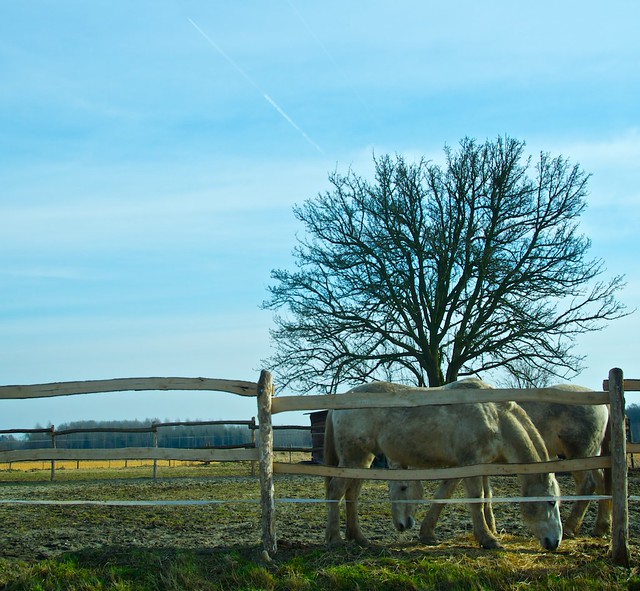
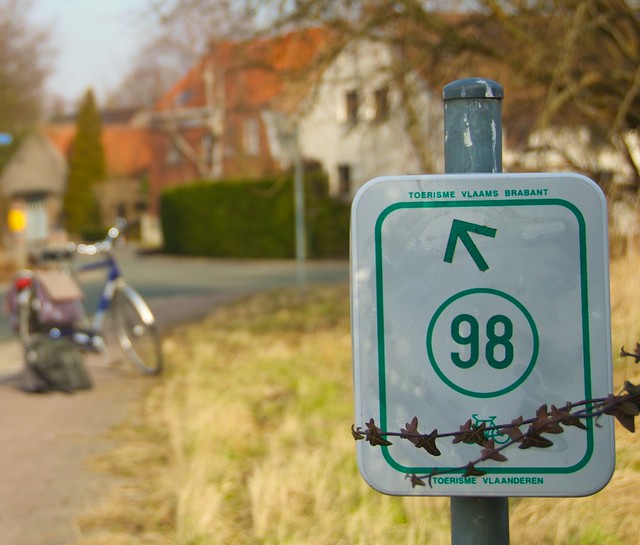



The Fietsnet is basically a Google map overlaid with connected bike-number systems. I wrote about using it here; on the zoek locatie (find location) tab type the city or area where you want to start. The map will zoom into the location and a series of red dots will appear. Click each red dot to choose the route. It may take a few tries. White lanes mean paved roads, orange means gravel or semi-hard (which can sometimes mean dirt or biking through a corn field), and blue is cobblestone. Sometime the Fietsnet will take you around a city if the city doesn't have good bike lanes. It's optimized for the bike rider because it avoids heavy car traffic areas, and it always opts for the most quiet and scenic riding situations. It is the single best way to explore Belgium. Exporting to GPS is possible. If you have questions or notice that signs are missing, take a minute to report it here. Check out there list of cycling websites too. Now, don't you want this idea of an online connected updated useful bike number trail system in the city/region/area/state you live? It makes travel without a car a complete and total reality? It is seriously the best thing ever.
The hubs and I biked to "Drie Fonteinen." There is a huge park in Vilvoorde with the same name, where the Brasserie Drie Fonteinen is also located (except in Vilvoorde). We intended to bike to 3Fonteinen in Beersel (drie = 3, fonteinen = fountains in Dutch). In the Flemish parts of Belgium, the Fietsnet is indispensable as a guide for planning a biking route (see end of post). Biking one-way and then taking the train back is a good day-trip option. Most cities in Belgium will be connected with trains, and a day pass for bikes is EUR 8.
In researching the destination and route of travel the hubs and I independently found the same location and didn't think twice about it. We even did this over several days. In fact, we wrongly read both sites and thought they were the same thing. So once we got to the Brasserie Drie Fonteinen we realized our mistake. We sat down and looked off the single lambic on the menu, and then ordered up some Grimbergens. We chuckled. What the heck else can you really do? So while the Brasserie Drie Fonteinen is not 3Fonteinen, it is a nice restaurant with a huge terrace and garden. And the mostly flat ride was quite enjoyable.
Beersel would have been too far anyways. Bieke, thank you for calling me when my minutes ran out and telling us the opening hours of our intended destination, and not laughing hysterically at me. You are too kind.





The Fietsnet is basically a Google map overlaid with connected bike-number systems. I wrote about using it here; on the zoek locatie (find location) tab type the city or area where you want to start. The map will zoom into the location and a series of red dots will appear. Click each red dot to choose the route. It may take a few tries. White lanes mean paved roads, orange means gravel or semi-hard (which can sometimes mean dirt or biking through a corn field), and blue is cobblestone. Sometime the Fietsnet will take you around a city if the city doesn't have good bike lanes. It's optimized for the bike rider because it avoids heavy car traffic areas, and it always opts for the most quiet and scenic riding situations. It is the single best way to explore Belgium. Exporting to GPS is possible. If you have questions or notice that signs are missing, take a minute to report it here. Check out there list of cycling websites too. Now, don't you want this idea of an online connected updated useful bike number trail system in the city/region/area/state you live? It makes travel without a car a complete and total reality? It is seriously the best thing ever.
February 21, 2012
Chevdo or Indian hot mix with spicy cornflakes and peanut snack



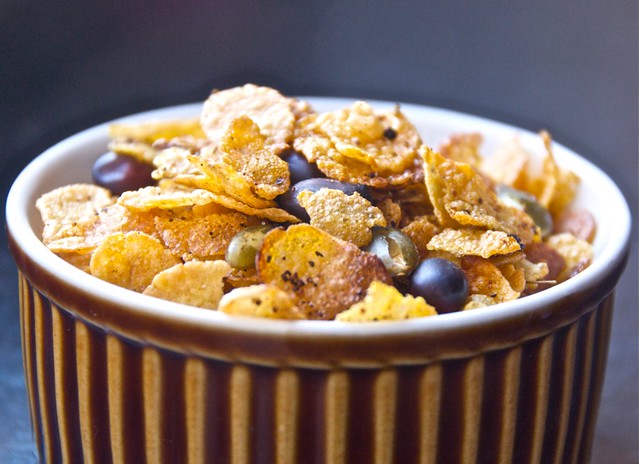
Chevdo is ubiquitous breakfast food in any south Asian household. It shows up at breakfast and snack times; it is carried on trips and packed with lunches often served with masala chai or coffee. It's basically spicy hot cornflakes or rice flakes, fried or toasted, and mixed together with hot peanuts, fried lentils, fried gram flour vermicelli (sev), rice crispies, and loads of red chili. I like it simple and healthy: a bit spicy, crunch from cornflakes, and pan-roasted peanuts balanced with toasted fennel, raisins, and pumpkin seeds. A ready made red chili garlic powder makes this really easy, but could easily be replaced with red chili, dried garlic powder, ground sesame powder, and lemon zest (or citric acid) or try this version here. If I'm not consuming chevdo in the morning along with my coffee, I really love it as a pre-dinner snack with a cold spicy Saison Dupont, or a citrusy witbier (wheat beer) such as Hoegaarden. It's great with masala tea or coffee as well.
Chevdo
South Asian or Indian spicy cornflakes with peanuts, raisins, and fennel seeds.
Ingredients:
1-2 tbsp peanut oil
1/2 cup or more raw peanuts
1 tsp whole fennel seeds
1/4 cup raisins
2 tbsp pumpkin seeds
4-5 cups cornflakes
1/4 tsp salt
1/4 tsp turmeric
1/4 tsp lemon zest
1 heaping tbsp dry garlic chili powder (such as this one from Deep foods, also called thechaa
Optional: popcorn, rice crispies, fried lentils, vermicelli (sev), toasted rice flakes (poha).
Directions:
In a heavy bottom pan (such as one to boil pasta) heat up 2 tbsp of peanut oil over medium heat. Once hot add in peanuts and roast over medium low heat for about 10 minutes. I used to never use the oil but I found the spices would all fall to the bottom, after trying it both ways, I'm happy using between 1-2 tbsp.
*Once the peanuts are done, turn the heat to low and then add raisins, they will plump up quickly. Add the pumpkin seeds, and fennel seeds. Add 1/4 tsp turmeric and salt and stir around. Add in 4 cups of corn flakes and stir together. Add in the dry garlic chili powder and the lemon zest, along with the last cup of cornflakes. Stir everything together. Tossing the pan back and forth is a good way to mix everything up without breaking the cornflakes.
*Note: My mother corrected my directions which have been updated from the original version. She is a minimalist at heart, so she could see no reason to dirty another pan which the original version had. I opt to roast the fennel seeds, raisins, and pumpkin seeds separately, but her chevdo is truly the better one so I updated my directions to reflect moms. Bus? Tik hé?
February 15, 2012
Belgian beer braised mushroom stew with fries (a stoofvlees variant)

I am in a food coma. I have a Duvel in my hand and a belly full of rumbly digestive noises. When I tell my Belgian friends that I'm going to make stoofvlees (a Belgian beef stew that uses a dark Belgian beer as the braising liquid) vegetarian they shudder with thoughts of "who the heck does this American think she is?" and "can it be done?" and "can i come over and try it and prove you wrong?"
The answers: she thinks she's awesome; yes and, yes and no. I had imagined using mushrooms the first time I viewed Jeroen Meus's version on Dagelijkse Kost. Something to soak up all the butter he uses and that will cook quickly and pair well with fries. This my friends, vrienden, is een echt lekkere vegetarische maaltijd. Now just imagine me saying, "nu we moet een kleine boter toevoegen daarna, ja, echt kleine stuk boter gesmolten." The contenders are a generous mix of mushrooms including bruine parijse, or basically compact and sturdy cremini mushrooms, along with white button mushrooms, diced white onions, lots of fresh herbs, garlic, Chimay blue (or to make it truly Flemish a St. Bernardus 12 or if I may be so bold to suggest a Westvleteren 12, or really any dark Belgian beer in the quadruple style with lots of spicy notes will suffice), mustard smothered bread, and butter - lots of it. I haven't even mentioned the fries yet!
Indeed, I did use a liberal amount of butter, but the resulting sauce is smooth and rich like velvet. The flip side of making this dish vegetarian is that you can make this dish fast on a weeknight, or when pressed for time. It cooks fast, and because it isn't stewing for hours the beer leaves more floral and fruity notes. You can serve it over mashed potatoes, but the hubs and I recently inherited a deep-fat fryer and attempted our first delicious batch of Belgian fries (how does one live in Belgium longer than two years and not get one is beyond me). They turned out golden, hot, crisp, salted to perfection with the proper salt to fry ratio. One naturally picks this up after watching numerous frietkot owners toss and toss and toss those fries.
This is a rich delicious stoofchampignon met frieten, or a braised beer and mushroom stew. Besides, every proper Belgian home has a frietketel or deep-fat fryer.
Beer braised mushroom stew with fries or stoofchampignon met frieten
Stoofvlees zonder vlees met champignons en frieten adapted from Jeroen Meus's Dagelijkse Kost
Serves: 4
Ingredients:
6 tbsp butter, all divided
2 cups white onions, diced
2 cloves garlic, minced fine
1 and 1/2 lbs mushrooms such as white button, cremini, and portabello mushrooms (or 350 g brown mushrooms, and 250 g white button mushrooms) wiped clean then quartered and halved.
1/3 cup chopped parsley
dried basil (maybe 1-2 tsp)
1-2 bay leaves
1 clove
1 bottle of Chimay Blue (or St. Bernardus 12, or a Belgian-quadruple style beer)
4-6 slices thin baguette smeared with strong dijon mustard
1/3 cup or more lingonberry jam, or other tart not sweet jam (apple butter is preferred)
lots of salt and pepper to taste
splash white wine vinegar to finish
Directions:
- Get out two wide pans, preferably one cast-iron. Start melting 2 tbsp of butter over medium-low heat in the non-cast iron one. When it gets hot, add the onions and garlic and cook until they just begin to sweat. Then turn the heat off.
- In the cast iron pan heat up 2 tbsp of butter over medium heat. Add half the mushrooms being careful not to crowd the pan. When the mushrooms begin to release water add them to the pan with the onions. Repeat with another 2 tbsp of butter.
- When the mushrooms are all cooked add them to the pan with the onions and turn the heat to medium. Pour the beer into the cast iron pan and let it heat up. Meanwhile, add the parsley, basil, bay leaves, cloves, salt and pepper to the onion pan. Once the beer is bubbling add it to the onion pan. Stir everything together and stir in the lingonberry jam or the apple butter.
- Slice off 5-7 thin baguette slices (or 2-3 normal sandwich slices) and smother them with a fancy Dijon mustard. Place these on top of the mushroom stew and simmer over medium-low heat until the sauce has thickened up a bit. Alternatively, you can dice up the bread and stir in about 2-3 tbsp of mustard along with the bread. The bread will dissolve into the stew. It's so good.
- Begin prepping the fries. Check on the mushroom stew often; it will reach it's desired thickness usually within 30 minutes.
Fries or frieten:
Note: Count at least 2 potatoes per person and probably 3 for guys, trust me, everyone scarfs down fries.
4-5 fry potatoes
1 liter of fry oil, or frituurolie; peanut oil is fine
A heavy bottom pan with a thermometer, or a deep-fat fryer
Directions for fries:
- Peel fry potatoes and cut them into thick sticks about 1/2" or 13 mm. Do not wash them. Any water on the fries will be bad news for hot oil, and it will get rid of the starch which will make the first crispy layer on the fry.
- Pour 1 L of fry oil (in Belgium there is special oil for the art of frying fries called frituurolie or fry oil) or peanut oil into a deep-fat fryer and heat up to 280º F/140º C.
- When hot add in the fries being careful not to overcrowd the pan or fryer. Fry about 5-6 minutes or until the fries look golden. Repeat with all the fries. When the fries are done remove them to a heat safe plate lined with paper towels.
- Turn up the heat on the fryer to 355º F/180º C. When ready, fry the once-fried fries until they are golden-brown and remove. Serve with mayo. I won't judge if you serve with ketchup or mustard. Toss the fries with salt in a wide bowl, and serve alongside the stoofchampignonsaus.
February 13, 2012
Food labels
No, not those kind of food labels: useful, straightforward ones - where the label actually tells you the ingredient, helps to organize the pantry, and makes clever use out of old cards that I can't seem to part with. Yes, those crafty cute food labels.
Did you ever read my bean queen post? If so, you'll know that I learned the art of pantry organization from my mother. She never resists to tell me how the space in the pantry could be better utilized if we got rid of our two shelves of our make-believe beer cellar.
These labels are made from stamps on paper, which are then glued (using ModgePodge) onto old birthday, postcards, wedding, and holiday cards. They are then taped onto glass and plastic jars. So far, so good. Clear lids are the best because I get a glimpse of handwritten notes on the back.

Traced out lids onto paper, then stamped.

Block letter stamps. I bought these from a MUJI store in Cologne.

Take an inventory of all your pantry goods. You'll forget at least two.

Artsy, craftsy. If I may (borrow from you Sara), no one was hurt in the making of this.
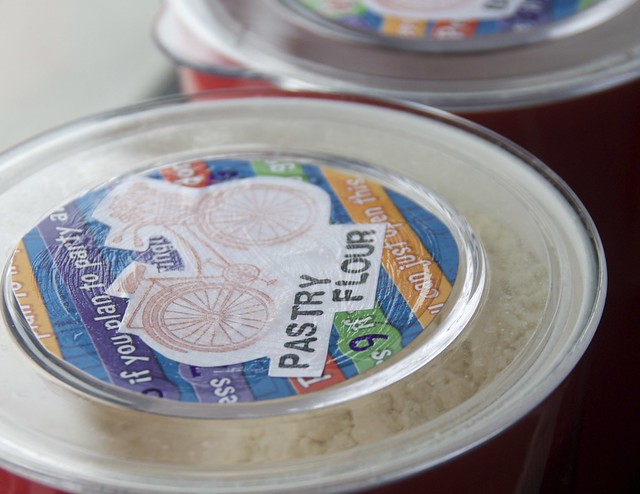


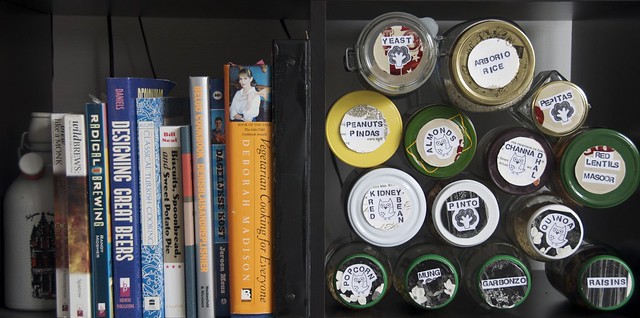
My attempt at "artsy" and "crafty" food shot. Fail.
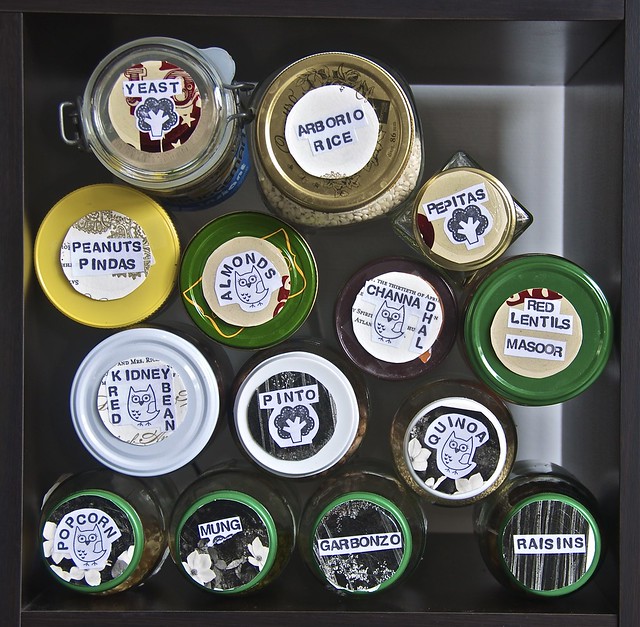
Here is a majority of the finished labels. I luffs them.
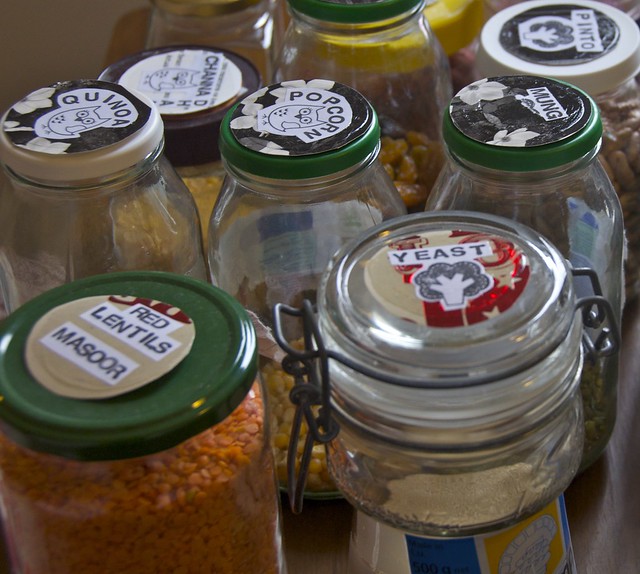
Reusing/repurposing glass jars.
Did you ever read my bean queen post? If so, you'll know that I learned the art of pantry organization from my mother. She never resists to tell me how the space in the pantry could be better utilized if we got rid of our two shelves of our make-believe beer cellar.
These labels are made from stamps on paper, which are then glued (using ModgePodge) onto old birthday, postcards, wedding, and holiday cards. They are then taped onto glass and plastic jars. So far, so good. Clear lids are the best because I get a glimpse of handwritten notes on the back.

Traced out lids onto paper, then stamped.

Block letter stamps. I bought these from a MUJI store in Cologne.

Take an inventory of all your pantry goods. You'll forget at least two.

Artsy, craftsy. If I may (borrow from you Sara), no one was hurt in the making of this.




My attempt at "artsy" and "crafty" food shot. Fail.

Here is a majority of the finished labels. I luffs them.

Reusing/repurposing glass jars.
Baked potatoes with lemon, feta, and herbs
Before the holiday break, the hubs and I were invited over for a Christmas party. We ate baked trout that was steamed in foil packets. The seasonings were simple: bay leaves, lemon slices, delicate garlic slices, and olive oil. It was divine. I try not to be judgmental with my vegetarian ways but hot damn that fish was unlike anything that could ever be recreated in the plant kingdom. So sometimes I cheat, but my vegetarian self always wins. I had to recreate those flavors. My idle time is not spent being bored. I got to work.
I use new potatoes, garlic, shallots, lots of fresh chopped parsley, lemon, capers, red kidney beans, generous pours of olive oil and capers. I carefully arrange everything in small cute foil pouches, and then away they go into the oven coming back steaming an hour later.
Oh heaven. This is vegetarian comfort food. Just in time for Valentine's Day too. I'll cook you this meal if you can come up with a prettier name than what I named it =-). Yes. They are not really cute, the foil gives them a rather industrial appearance, but trust me these are delicious.

Unwrapped baked potatoes




I really wanted to make these last two images an animated gif. I resisted.

Unwrapped baked potatoes




I really wanted to make these last two images an animated gif. I resisted.
Baked potatoes with lemon, feta, and herbs
Serves: 4
Ingredients:
1 packet of aluminum foil, or enough for 4 10" by 10" squares
4-6 small-medium new potatoes, peeled and sliced into 1/2" rounds
scant 1 cup fresh chopped parsley, can sub chopped dill
1/3 cup chopped shallots
1/3 cup chopped shallots
2 cloves garlic, chopped fine
1 lemon sliced (enough for 1-2 slices in each pouch)
4 bay leaves
1-2 tsp capers (do not rinse them)
1/2 cup feta cheese
1-2 cups cooked kidney beans (canned beans are fine)
olive oil
Directions:
1. Preheat oven to 350 º F; arrange everything on a plate, and then lay out foil squares (10" by 10").
2. The order in which the ingredients go don't really matter, although it's probably easiest to start with the potatoes. Pour a bit of olive oil onto the middle of the foil. Place a bay leaf on top and then place about 6 slices of potatoes on top. Top with parsley, shallots, capers, garlic and lemon slices. Arrange feta cheese and beans on top. Pour a generous glug of olive oil over the top, crack some fresh black pepper on top, and then fold into pouches like folding an envelope.
Repeat with the ingredients to make 4 pouches. Arrange on a baking sheet and bake in the oven for an hour or less. Serve with some warm crusty bread to soak up the juices.
February 9, 2012
Banana oat muffins and nutrition ranting
The older I get the crankier I get with nutrition - especially because I think about how connected food and environment are to one another, and how regardless of the sheer outcome and breadth of many nutrition studies, there is no framework to pump the changes into, or rather that those changes seem excessively slow. When I learn about European (and here I mean country-specific) nutrition policies I can't help but think that the US is in the dark ages. Don't worry I will share those in another post.
I was especially disheartened to read about a study that was recently published in the Archives of Pediatrics and Adolescent Medicine which found students at half of US elementary schools could buy unhealthy foods outside of school meals. These are competitive foods such as cookies, cakes, and baked goods which are usually sold through vending machines, a la carte lines in the cafeteria, and in school stores. Researchers found that unhealthy snack foods were sold more in the south, where obesity rates are the highest - in fact 60% of public elementary schools in the south were found to be selling unhealthy foods; in the west this number drops to 24%, and in the midwest it is 30%. While the study found that fruits and vegetables were offered to be sold as well, they didn't sell as well as sugary salty foods (duh). If you follow Food Politics, or the Lunch Tray, you may have read about the recent changes, and the pushback, and then again the move forward with updated new federal nutrition guidelines for school nutrition (elementary through high school). Before these new regs were published, competitive foods were exempt from federal regs, but now they are included in the report as being bound by the same criteria, and the report suggests that competitive foods follow the Institute of Medicine's report. I look forward to Bettina Elias Siegel's school nutrition FAQ. I hope that we can transition to real foods, move away from nutrient reductionism, and take back our food culture. Public schools, where most children learn fundamental basics about their world, have a place in changing food culture, and teaching students how to understand and apply nutrition.
Walmart recently announced their own front-of-package nutrition labeling system. Marion Nestle of Food Politics does an excellent write up on Walmart, presents research on labeling (e.g. a stoplight system works very well), and how Walmart should have waited to release guidelines so they could be in line with the FDA's front-of-package labeling guidelines. Should Walmart be providing their own nutrition labels on the front of packs? Probably not, but they are responding to increasing consumer demand that may help to alleviate the guilt that people probably feel when they feel overwhelmed by the nutrition label; or it's good for business, and it looks like they did something positive; or it will generate good PR and increase sales. Regardless, I still think it shows that businesses change their strategies to meet consumer demand. These changes coupled with concrete federal nutrition polices on advertising and labeling could make it very difficult for food and beverage companies to market and sell bad foods. And this just hot off my RSS: food companies using the First Amendment to market and sell any foods to kids. Marion Nestle why are you such a bad ass?
And finally some good nutrition news. When I was doing my catch-up reading on portion sizes for this month's month of meals, I came across an article from Harvard that revamped muffin recipes. Muffins are the poster child for portion distortion. Stacked on top of each other at coffeehouses, they are closer to processed cakes and cookies than healthy breakfast food. The average size of a muffin has probably quadrupled in size, and it's packed full of refined flour and sugar. Muffins can actually be quite healthy and reasonable. So as you become more enraged, or interested in the nutrition news out of the US, I find I actually enjoy writing about these things, I wanted to share some healthy banana oat muffins I baked up this morning:
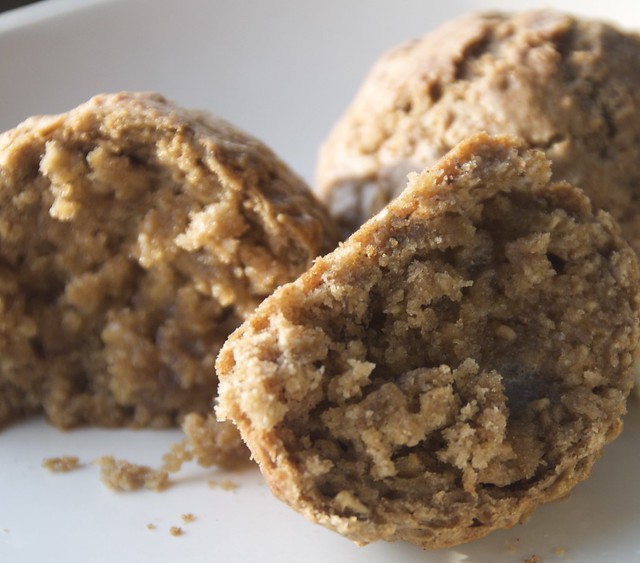

nom nom nom nom
Banana oat muffins
Recipe from Deborah Madison's VCFE
Yield: 1 dozen
Ingredients:
2 large ripe bananas
3/4 cup buttermilk or 1/2 yogurt thinned with water
1/3 cup brown sugar (can use 1/4 cup with equally good results)
1 egg
2 tbsp canola or peanut oil
1 cup rolled oats
1 and 1/2 cups whole-wheat pastry flour
1 tsp nutmeg or cinnamon
1 and 1/2 tsp baking soda
1/2 cup walnuts, optional
Directions:
I've made this recipe so many times that I've experimented with 1 banana (turns out just fine); I forgot to add the oil once (it was fine, but was a bit dry on day 2 and 3); I subbed cinnamon for nutmeg; I reduced the sugar from 1/3 cup to 1/4 cup and it was the same; I experimented with using milk instead of water (3/4 cup milk + 1 tsp vinegar = acceptable buttermilk substitute); I have used the following flour proportions which have all been excellent: 1) 1/2 all-purpose and 1/2 whole-wheat flour, 2) 100% whole-wheat flour, and 3) half pastry flour and half whole wheat.
I was especially disheartened to read about a study that was recently published in the Archives of Pediatrics and Adolescent Medicine which found students at half of US elementary schools could buy unhealthy foods outside of school meals. These are competitive foods such as cookies, cakes, and baked goods which are usually sold through vending machines, a la carte lines in the cafeteria, and in school stores. Researchers found that unhealthy snack foods were sold more in the south, where obesity rates are the highest - in fact 60% of public elementary schools in the south were found to be selling unhealthy foods; in the west this number drops to 24%, and in the midwest it is 30%. While the study found that fruits and vegetables were offered to be sold as well, they didn't sell as well as sugary salty foods (duh). If you follow Food Politics, or the Lunch Tray, you may have read about the recent changes, and the pushback, and then again the move forward with updated new federal nutrition guidelines for school nutrition (elementary through high school). Before these new regs were published, competitive foods were exempt from federal regs, but now they are included in the report as being bound by the same criteria, and the report suggests that competitive foods follow the Institute of Medicine's report. I look forward to Bettina Elias Siegel's school nutrition FAQ. I hope that we can transition to real foods, move away from nutrient reductionism, and take back our food culture. Public schools, where most children learn fundamental basics about their world, have a place in changing food culture, and teaching students how to understand and apply nutrition.
Walmart recently announced their own front-of-package nutrition labeling system. Marion Nestle of Food Politics does an excellent write up on Walmart, presents research on labeling (e.g. a stoplight system works very well), and how Walmart should have waited to release guidelines so they could be in line with the FDA's front-of-package labeling guidelines. Should Walmart be providing their own nutrition labels on the front of packs? Probably not, but they are responding to increasing consumer demand that may help to alleviate the guilt that people probably feel when they feel overwhelmed by the nutrition label; or it's good for business, and it looks like they did something positive; or it will generate good PR and increase sales. Regardless, I still think it shows that businesses change their strategies to meet consumer demand. These changes coupled with concrete federal nutrition polices on advertising and labeling could make it very difficult for food and beverage companies to market and sell bad foods. And this just hot off my RSS: food companies using the First Amendment to market and sell any foods to kids. Marion Nestle why are you such a bad ass?
And finally some good nutrition news. When I was doing my catch-up reading on portion sizes for this month's month of meals, I came across an article from Harvard that revamped muffin recipes. Muffins are the poster child for portion distortion. Stacked on top of each other at coffeehouses, they are closer to processed cakes and cookies than healthy breakfast food. The average size of a muffin has probably quadrupled in size, and it's packed full of refined flour and sugar. Muffins can actually be quite healthy and reasonable. So as you become more enraged, or interested in the nutrition news out of the US, I find I actually enjoy writing about these things, I wanted to share some healthy banana oat muffins I baked up this morning:


nom nom nom nom
Banana oat muffins
Recipe from Deborah Madison's VCFE
Yield: 1 dozen
Ingredients:
2 large ripe bananas
3/4 cup buttermilk or 1/2 yogurt thinned with water
1/3 cup brown sugar (can use 1/4 cup with equally good results)
1 egg
2 tbsp canola or peanut oil
1 cup rolled oats
1 and 1/2 cups whole-wheat pastry flour
1 tsp nutmeg or cinnamon
1 and 1/2 tsp baking soda
1/2 cup walnuts, optional
Directions:
- Preheat oven to 375º F/190º C.
- Lightly grease muffin pan with oil.
- In a large mixing bowl mix mash the bananas, and add an egg and the oil. Mix it together a bit. Then add the buttermilk, brown sugar, and oats. Mix it together stirring with a big spoon.
- In a small mixing bowl, combine the flour with cinnamon and baking soda. Add this to the big mixing bowl. In swift strokes mix everything together until the batter just comes together. Spoon about 1/4 cup or more into the muffin pan. Bake for 20-25 minutes, or until golden and fragrant. Once cool store leftovers in an airtight container. This makes an awesome breakfast with a bit of fruit and hot steaming coffee.
I've made this recipe so many times that I've experimented with 1 banana (turns out just fine); I forgot to add the oil once (it was fine, but was a bit dry on day 2 and 3); I subbed cinnamon for nutmeg; I reduced the sugar from 1/3 cup to 1/4 cup and it was the same; I experimented with using milk instead of water (3/4 cup milk + 1 tsp vinegar = acceptable buttermilk substitute); I have used the following flour proportions which have all been excellent: 1) 1/2 all-purpose and 1/2 whole-wheat flour, 2) 100% whole-wheat flour, and 3) half pastry flour and half whole wheat.
February 5, 2012
Park Abbey (Abdij van 't Park)
Remember that online photography course I shared a few posts back? The hubs has been more studious than me as evidenced by his beautiful pics. It snowed this past week. Snow makes cold weather more manageable, until you realize you have to walk your bike everywhere. These were taken at the Park Abbey (Abdij van 't Park). A short walk from our place.


















February 1, 2012
February MoMe
Here’s February’s MoMe; (click text to download and print).
The meal plan has a biweekly grocery list, but I figured I’d just go ahead and try and explain how I use the meal planning, and share some positive unintended outcomes. I go grocery shopping at least once per week, and sometimes more often. I hit up the fresh markets for produce, and grocery stores for most of the rest. I do this because I don’t have a lot of space to store things. I don’t like grocery shopping. It seems like a hassle, it’s time-consuming, and I’m limited to what I can carry back on my bike (saddlebags + backpack), or on foot (grocery cart + backpack + extra bags). I get sidetracked reading labels, navigating the store, waiting in line, forgetting something and having to backtrack - all in all, not much fun. Having a well-planned list forces me to buy things that I need, stick to the list, and become more aware of what I have at home. Of course, I’m currently motivated to try this out and use it, so some of these outcomes are probably biased.
With MoMe, I spend more time planning, preparing, and shopping. It's reduced the amount of time stressing over what to eat so I don't panic and pop in a frozen pizza, and provides ready-made lunches. I’ve been analyzing the food costs more closely, and it’s actually driven down our total food expenditures, without feeling deprived or sticking to a hard budget. For example, I recently bought the following to restock some pantry staples:
| 3.99 | 2 kg dried chickpeas (about 4.4 lbs) |
| 2.59 | 2 kg of dried pintos (again about 4.4 lbs) |
| .89 | ½ kg red lentils (about 1 lb) |
| 1.25 | 1 kg raw peanuts (2.2 lbs) |
| 1.30 | ½ kg whole kernel popcorn (about 1 lb) |
| 2.10 | 1 kg dried kidney beans (2.2 lbs) |
| €12.12 | Total (or $16.72 in USD) |
Canned beans are convenient, but when compared to the cost of buying raw ingredients, raw ones are cheaper. Soaking and cooking 1 cup of dried beans will double in volume to about 2 and 1/2 cups. This will prepare more food (more servings) than what is going to come out of a 14 oz can of canned beans (4oo g; which when emptied, drained, and rinsed will yield about 1 and 1/4 cups). Vegetarian ingredients (on just a weight basis) tend to be much cheaper than meats. The volume of food obtained from cooking raw beans provides more food than the original amount; the volume of food obtained from cooking raw meats is less than the original amount. In comparison, €12.00 buys around a 1 lb (2.2 kg) of boneless chicken breast, and feeds you much less frequently; although a whole chicken could be purchased and used in many other meals.
Currently, nutritional portion sizes for foods that contain protein are measured out in 1-ounce equivalents. I know, now you're wondering how much protein do I need? Chances are that you probably overeat this macronutrient. Using the term ounce-equivalents is confusing because foods that contain protein all have different values on what makes a serving/portion (I use the word serving and portion size interchangeably), and further no one measures food out this way. For example, 1/4 cup of beans is a 1 ounce-equivalent. If you checked how much you need on the online chart linked just before, you'll see that a grown woman needs around 5-5 1/2 ounce-equivalents; a man 6-6 1/2 ounce-equivalents. Dietitians use .8 g/kg - but let's forget that. If you checked the first link in this paragraph, you will have noticed the following constitutes a 1 ounce-equivalent: 1 egg, 1 ounce of meat, 1 tbsp of peanut butter, 1/2 ounce (1 handful) of nuts, and 1/4 cup of cooked beans (I'm going for simplicity, and I don't feel like including gram measurements for all of that).
Let's go further and compare what people *actually* eat out of those listed. Egg dishes such as scrambled or omelette dishes usually contain 2-3 eggs per person (can be up to 6 if you eat out) which equals between 3 and 6 ounce-equivalents. Next up, servings of meat at home are often between 3 and 5 oz, or about the size of your palm (at restaurants they are 8-16 oz, like the size of your head) - again keep in mind the ounce-equivalent. Making a peanut butter sandwich, chances are you'll opt for at least 2 tbsps; I didn't even get into other foods that contain proteins: tofu, milk, yogurt, cheese, whole-grain breads and seeds, some vegetables. It's crazy isn't it? You wonder why people are so confused about nutrition and diet. Understanding serving sizes/portion sizes is a steep learning curve, but it's among one of the best tools you can use when cooking and eating. It helps to estimate the amount of food required, it helps maintain your weight, and it ensures you're eating foods healthfully.
So inevitably you want information on the others:
Grains: foods from this group are measured in 1 ounce equivalents. Eat more whole-grain foods and less refined. Each of these is a 1 ounce equivalent: 1 slice of bread, 1 cup of ready-to-eat cereal, or ½ cup of cooked rice, cooked pasta, or cooked cereal, 1, 6” tortilla or roti.
Fruits: foods from this group are measured in cups. The following are servings: 1/2 banana, 1 cup of fresh fruit, 1/2 cup of dried fruit, and 1/2 cup 100% fruit juice. Although fruit juice counts (it shouldn't), it is healthier and recommended to consume whole fruits (fiber, nutrition, reduced spike in blood sugar, etc). Most people need to eat 2 cups of fruits daily.
Vegetables: are also measured in cups. The following measurements count towards 1 serving from the vegetable group: 2 cups raw leafy greens, 1 cup raw or cooked vegetables, and in some cases, 1/2 cup of cooked vegetables (such as cooked greens). Most people need 2-3 cup equivalents of vegetables daily.
Fruits: foods from this group are measured in cups. The following are servings: 1/2 banana, 1 cup of fresh fruit, 1/2 cup of dried fruit, and 1/2 cup 100% fruit juice. Although fruit juice counts (it shouldn't), it is healthier and recommended to consume whole fruits (fiber, nutrition, reduced spike in blood sugar, etc). Most people need to eat 2 cups of fruits daily.
Vegetables: are also measured in cups. The following measurements count towards 1 serving from the vegetable group: 2 cups raw leafy greens, 1 cup raw or cooked vegetables, and in some cases, 1/2 cup of cooked vegetables (such as cooked greens). Most people need 2-3 cup equivalents of vegetables daily.
As part of the 70% of the rest of the world that doesn't digest lactose, and questions the science behind dairy promotion in nutritional recommendations that should be promoting foods and activities that promote bone health (weight-bearing exercises, calcium, gender, race, Vitamin D and K) I'm with Harvard. They tend to synthesize nutrition information in a useful, no-nonsense practical way.
Fats: there is lots of evidence that supports the use of plant-based oils in cooking and baking, limits the use of butter, and avoids trans fats. Fats play a role in digestion and absorption, help to carry flavor, and contribute to feeling full (among many others).
I digress. Since February is still among the darker months, there are some oven-baked dishes; a creamy penne vodka can be a celebratory dish for Valentine’s day (or do a cheese and chocolate fondue night, or maybe the chickpea piccata). Gin is an acceptable substitute. An excellent aperitif are dirty martinis. I tried to pair dishes together so a meal that takes longer to prepare one evening, can be used in conjunction with the next day’s meal. Make enough pizza dough to cover two evening meals; when cooking rice, double the amount to use the next day. In week 2, the meals have cheese, so round out the week with a hearty bean and veggie chili.
Now, some picas of recipes on this month's MoMe:
Chickpea piccata [Feb MoMe]. I've tried this with arugula, spinach, and now broccoli. Always delicious.
Pizza night [Feb MoMe]; My friend Nico's homemade pizzas; I have a lot to learn.
Baked stuffed tomatoes [Feb MoMe].
Tofu tikka masala kebabs [Feb MoMe]; excellent served over rice or salad.
Pav Bhaji served in pita [Feb MoMe].
Tartiflette [Feb MoMe].
omg that was a long one wasn't it!? As always if you use this and hate or love it, please leave feedback. Until next month, happy eats y'all. I got my chickpeas soaking.
Subscribe to:
Posts (Atom)




